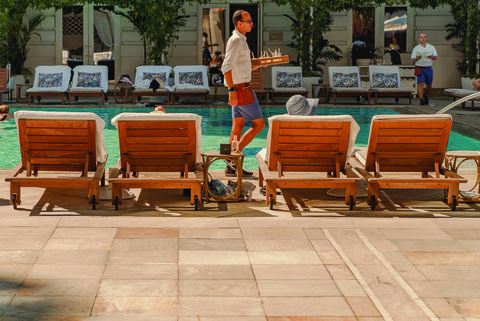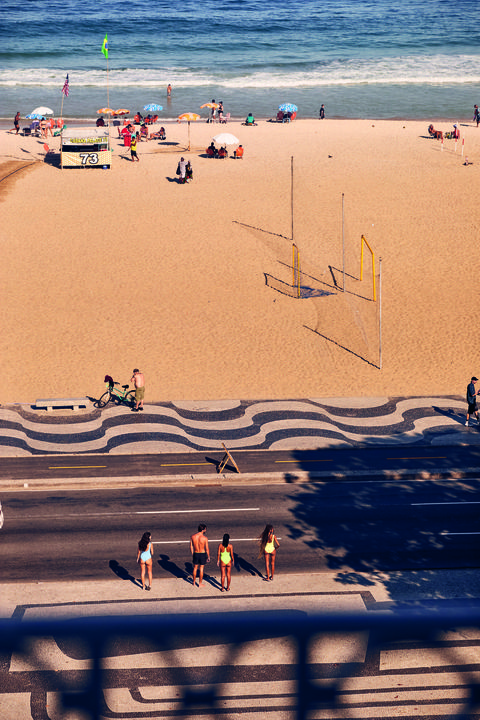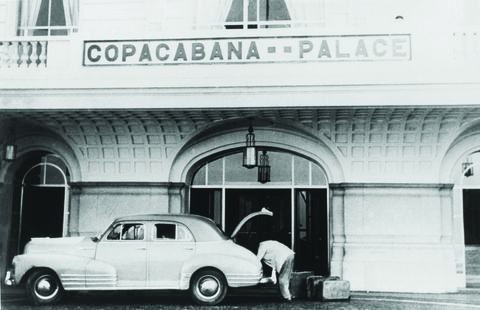Here Fred Astaire and Ginger Rogers tap-dance to the 1933 classic Flying down to Rio. Here, Diana and Charles had a memorable quarrel during which the princess allegedly refused to sleep with him by diving into the pool at two in the morning. Also here, according to legend, Mick Jagger would have conceived his illegitimate child. And still here, or rather, on the beach in front, the Rolling Stones organized in 2006 one of the most extraordinary live shows ever in front of over one and a half million people. We are talking about the Copacabana Palace Belmond Hotel, one of the most iconic hotels on planet earth. A place of worship, a symbol of Rio de Janeiro and Brazil, which is celebrating its one hundredth birthday this year. The list of guests who have stayed in this gigantic 1930s-style white building is impressive. From movie stars to the aristocracy. From the future King of England Edward VIII to King Albert I of Belgium, from Marilyn Monroe to Joan Fontaine, from Jane Mansfield to Brigitte Bardot, from Nelson Mandela to Francis Ford Coppola up to Justin Bieber. In short, if Copacabana beach is a myth today, a small part of the credit also goes to this luxurious hotel which over the last century has managed to shape the architecture of the buildings that frame the Avenida Atlantica promenade which culminates with the majestic Sugar Loaf.
The history of La Copa, as they call it in these parts, begins in 1922, the year in which businessmen Francisco Castro Silva and Octávio Guinle finance the project entrusted to the French architect Joseph Gire (the same one who designed the Hotel Negresco di Nozza and the Hotel Carlton in Cannes). The goal was to give birth to the hotel in 1922 on the occasion of the centenary of Brazil’s independence in 1922. The official opening will take place a year later. The large structure is inspired by the great hotels of the French Riviera. Particularly at the Carlton. From 1923 onwards it is a continuous ascent. Here Walt Disney creates the parrot character Ze Carioca, Marlene Dietrich records her live album “Dietrich in Rio”, Ella Fitzgerald gives a mythological concert in the Golden Room. In 1942 it was the turn of Orson Welles. The director is a guest at the hotel for eight long months while working on a documentary about Rio. Filming will then be interrupted by the production due to the artist’s constant whims, who spends his days amidst champagne and women. One of these, the Mexican actress Dolores del Rio, drives him literally crazy leading him to throw all the furniture in the room, including the piano, out of the window of his suite. A six-story flight that ends in the pool below. In 1962 the director Steno even dedicated a film to the structure Copacabana Palace in which Walter Chiari and Sylva Koscina perform as well as some masters of Bossa Nova such as Antonio Carlos Jobim, Luis Bonfà and Joao Gilberto. One of the best-known photos of Brigitte Bardot besieged by paparazzi is taken here. It is 1964 and the pressure of the local press on the French star is such that BB, after a press conference, is forced to leave Rio for Buzios, the idyllic coastal Brazilian city that will become her South American retreat. The decline begins when Brasilia becomes the capital, taking away the status of the more enjoyable and colorful Rio. In 1985 there was talk of closing everything down, of dismantling the palace. In 1989, the arrival on the scene of Belmond (at the time the group was called Orient-Express) brought the white Art Deco building (eight floors with 148 rooms and a 14-storey annexe with 78 rooms) back to its rightful place.
To celebrate its first century of life, a calendar of parties has been established for each month of the year (the hashtag is #100doCopa). International chefs, gala dinners (one of the three restaurants is the Cipriani headed by chef Nello Cassese), concerts, parties. A commemorative coffee table book by travel writer Francisca Mattéoli, whose family has owned the Copacabana Palace since it opened, is due for release in November. But that is not all. Even contemporary art carves out its own important space. Merit of the MITICO project, set up in collaboration with the very Italian Galleria Continua, which will transform the Carioca hotel into a wonderful art gallery where installations will flourish here and there. Icing on the cake: the theater. In fact, the Copacabana Palace Theater is located next to the hotel. Closed for thirty years, it will see the light again thanks to Belmond who restored it with the famous Brazilian architect Ivan Rezende. The project, which involved more than 600 artisans, from wood carvers to carpenters to designers, will transform this stage into one of the cultural reference points of the Carioca city.





